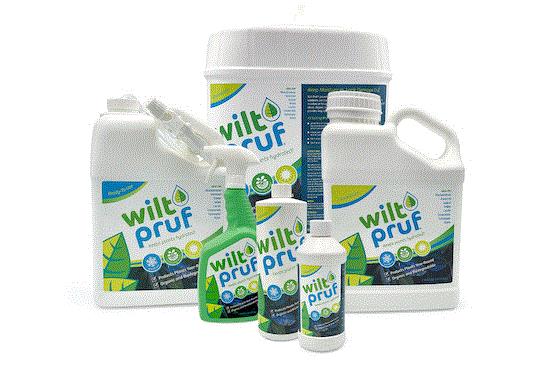Mole & Vole Repellent
In the last newsletter, I mentioned that repellents typically containing capsaicin or thiram are often used to deter rodents from entering and/or feeding on perennials being overwintered. After I sent out the newsletter, I received feedback from Tim McGinty of North Creek Nursery about Mole & Vole Repellent from I Must Garden that they have been using successfully. In Tim’s words, “We used to get destroyed until we found this.”
I’ve known Tim for a number of years and I know he’s likely trialed this as well as other repellents, so if he says it works, it most likely does. That’s why I thought I’d pass this information along.
I Must Garden's Mole & Vole Repellent is all natural and contains just three ingredients: caster oil, peppermint oil and cedar oil. Along with the pests in the name, it’s also effective at repelling armadillos, gophers, skunks, chipmunks and ground squirrels.
Applying Repellents
From my understanding, the most common approach people use when applying repellents is to treat the entire area all at once. Now, while this may be the approach we use when applying insecticides or fungicides, this is not the best method for getting optimal results when using repellents. When using repellents, think of how you can best move the rodents off your property or away from the areas being treated. By nature, you’re methodically moving the rodents from treated to untreated areas.
Here are two graphics from the I Must Garden website (see the "How To Apply" tab towards the bottom of the page) showing how to apply repellents in stages to move the rodents away from the areas you want to protect the most.
Example A: Start at one end of your property and move pests toward an exit point off your property.

Example B: Start at a central location and gradually move pests outward to create protected barriers moles and voles will avoid.
Once the rodents have been moved away from the treated areas, effective control can be maintained by regularly applying a 10- to 20-foot border of repellent to prevent rodents from entering the areas you wish to exclude them from. Reapplication intervals vary from 30 to 90 days depending on the situation and rodent pressure.

Wilt-Pruf for Cold Protection
Following my last newsletter, I had a conversation with Martin Pratt from Wilt-Pruf about using anti-transpirants for protecting plants from cold during the winter months. It was a great conversation and I learned a lot—so much, in fact, that I thought I’d share the conversation with you:
PAUL: I’ve heard of some growers using anti-transpirants on perennials being overwintered. Before we talk about this use, can you please give me a quick overview of what Wilt-Pruf is and how it works?
MARTIN: Post World War II, there was a building boom, and landscapers found themselves transplanting shrubs and trees in July and August, which are not ideal climates given the water requirements. In response to this boom, Luther von Gartner invented the first anti-transpirant, calling it “Wilt-Pruf.” While a new ownership team is in place now, it’s the same product that has been trusted for over 60 years.
Organic and bio-degradable, it creates a multi-layer protective coating on plant foliage and stems that reduces respiration during periods of stress whenever water intake is diminished—like during summer droughts or harsh winters.
PAUL: How does Wilt-Pruf provide these benefits without interfering with necessary processes such as photosynthesis and respiration?
MARTIN: Wilt-Pruf doesn’t polymerize on a plants foliage or stems until it is activated with outdoor UV light, meaning all the layers below the top layer haven’t hardened off. This technology creates a breathable film, which doesn’t materially affect osmosis, respiration or photosynthesis. Plants get natural protection from harsh climates, but they are still able to respirate the same way they would without protection during moderate climates. Our CEO equates it to layering your clothing in the winter or wearing sunscreen during the summer. Your body is still operating as it normally would, but you are getting the protection you need to continue functioning at a high level regardless of the climate.
PAUL: I’ve heard of Wilt-Pruf being used for wind protection, but how does Wilt-Pruf protect plants from cold exposure?
MARTIN: High winds, cold winters and summer droughts all have one thing in common: they materially impact a plant’s ability to retain water. In the case of high winds and summer drought, moisture is typically leaving the foliage and stems at a quicker rate than most people can water (or afford to water). During the winter, plants harden off so they are relying on the moisture their root system absorbed pre-freezing. Wilt-Pruf reduces the rate of transpiration so during the harsh winter months the plant loses less water, which helps prevent winter kill come spring.
PAUL: Will applications of Wilt-Pruf in the fall help plants to become better acclimated to cold? And if so, what is the best recipe for success when using Wilt-Pruf for overwintering perennials?
MARTIN: As temperatures start to drop in the fall, plants become less active as they prepare for winter. We recommend spraying in late fall after a thorough watering. We recommend spraying Wilt-Pruf at temperatures above 40F, although you can technically spray at temperatures lower than 40F, assuming Wilt-Pruf doesn’t freeze on the foliage and stems during application. Applying during this window will help plants, trees and shrubs as the temperatures continue to cool. This single application will provide up to four months of protection.
PAUL: Does Wilt-Pruf protect all plants from cold or just certain types? For example, I can see there would be benefits for using Wilt-Pruf on evergreen perennials during overwintering, but I wonder about its benefits on deciduous perennials or plants that completely lose their foliage during dormancy.
MARTIN: We’ve tested Wilt-Pruf on a large variety of plants, trees and shrubs over the past 60-plus years and have determined you can apply to just about any outdoor plant, including perennials. That being said, Wilt-Pruf is not for everything. Based on our research, we have the following disclaimers: (1) we don’t recommend using it on plants with hairy leaves; (2) do not use on African Violets or exotic, slow-growing dwarf plants; (3) do not apply on arborvitae, cypress, juniper or cedar until the plants have hardened off for the winter (our scientists recommend using ground freezing as a key indicator); (4) product will turn blue spruce green temporarily; and (5) when in doubt, use a high dilution rate (e.g., 1:15) and test before applying fully.
PAUL: Can growers easily see that Wilt-Pruf is working?
MARTIN: If Wilt-Pruf is applied year-round at the correct intervals, we are confident that landscapers, growers and gardeners will see healthier plants. You will see less winter kill, increased transplanting success and reduced water needs, as we’ve proven for more than 60 years. Think of Wilt-Pruf like Vitamin C for humans—we take it to help ward off getting sick during the winter; the anti transpirant is similar in slowing down the effects of moisture loss before damage occurs.
 PAUL: What product sizes are available and where can growers purchase Wilt-Pruf?
PAUL: What product sizes are available and where can growers purchase Wilt-Pruf?
MARTIN: The product comes in a variety of sizes, including 32-ounce and 1-gallon ready-to-use (RTU), as well as concentrates (pint, quart, 1-gallon, 5-gallon and 55-gallon). Depending on the volume needed, growers can purchase directly from Wilt-Pruf, through professional distributors such as BFG Supply, Arett and Griffin Greenhouse, or at commercial wholesalers like A.M. Leonard and Site One Landscaping. Those attending the MANTS show in January can also stop by our booth and speak to me further.
Martin, thanks for sharing this information with me and my readers. We definitely learned a thing or two about how anti-transpirants work.

It’s Time for January Trade Show Season
Since Martin just mentioned MANTS, I thought I’d pass along several of the other great trade shows going on in January. Click the name of the trade show to get the details of each event.
These are the trade events I thought would be of most interest to growers and garden centers, but there are numerous other trade shows going on. Check out Ball Publishing’s
HortCalendar (
https://www.hortcalendar.com/) for more events going on in January and throughout the year.
CAST 2023
With winter in full force and the holiday season upon us, it’s hard to believe that spring isn’t that far away, and one of my favorite spring activities is to visit the California Spring Trials, aka CAST.
|

The GrowerTalks Bobbleheads: Chris Beytes, Jen Zurko, Bill Calkins and video producer Osvaldo Cuevas
|
 CAST 2022: Darwin Perennials CAST 2022: Darwin Perennials
|
CAST will be held March 29 – April 2. Unlike many events that are held at a single venue, CAST is held at ten separate locations spread across scenic central and northern California. While it's primarily a bedding plant event, I anticipate this will be a year full of new perennial introductions from numerous companies, including Benary, Danziger, Darwin Perennials, Dümmen Orange, Greenfuse Botanicals, Kieft Seeds, Plant Haven, Syngenta Flowers, Think Plants, Pacific Plug & Liner and more.
GrowerTalks has a great website dedicated to booking your CAST trip. It includes information on each trial location, as well as the editors' recommendations on where to stay and where to eat. Check it out:
https://www.growertalks.com/CaliforniaTrials/ 




Thanks for reading this edition of Perennial Pulse. I hope you have a great and safe holiday season.
My email is paul@opelgrowers.com if you have any comments, article suggestions or if you'd just like to say hello.
Stay warm!
Paul Pilon
Editor-at-Large—Perennial Pulse
Director of Growing—Opel Growers
This email was received by you and 35,157 other fine subscribers!
If you're interested in advertising in Perennial Pulse, contact Kim Brown ASAP and she'll hook you up.